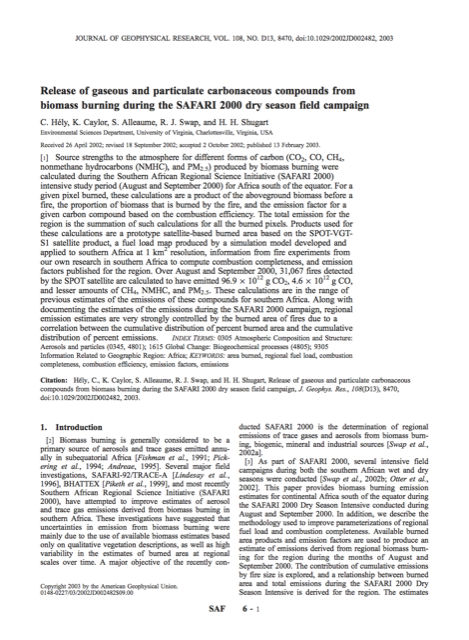Release of gaseous and particulate carbonaceous compounds from biomass burning during the SAFARI 2000 dry season field campagin

Hély, C., Caylor, K., S. Alleume, R.J. Swap, and H.H. Shugart (2003). “Release of gaseous and particulate carbonaceous compounds from biomass burning during the SAFARI 2000 dry season field campagin.” Journal of Geophysical Research – Atmospheres, 108(D13):8740-8750.
Source strengths to the atmosphere for different forms of carbon (CO2, CO, CH4, nonmethane hydrocarbons (NMHC), and PM2.5) produced by biomass burning were calculated during the Southern African Regional Science Initiative (SAFARI 2000) intensive study period (August and September 2000) for Africa south of the equator. For a given pixel burned, these calculations are a product of the aboveground biomass before a fire, the proportion of biomass that is burned by the fire, and the emission factor for a given carbon compound based on the combustion efficiency.
The total emission for the region is the summation of such calculations for all the burned pixels. Products used for these calculations are a prototype satellite-based burned area based on the SPOT-VGT-S1 satellite product, a fuel load map produced by a simulation model developed and applied to southern Africa at 1 km(2) resolution, information from fire experiments from our own research in southern Africa to compute combustion completeness, and emission factors published for the region.
Over August and September 2000, 31,067 fires detected by the SPOT satellite are calculated to have emitted 96.9 x 10(12) g CO2, 4.6 x 10(12) g CO, and lesser amounts of CH4, NMHC, and PM2.5. These calculations are in the range of previous estimates of the emissions of these compounds for southern Africa. Along with documenting the estimates of the emissions during the SAFARI 2000 campaign, regional emission estimates are very strongly controlled by the burned area of fires due to a correlation between the cumulative distribution of percent burned area and the cumulative distribution of percent emissions.
